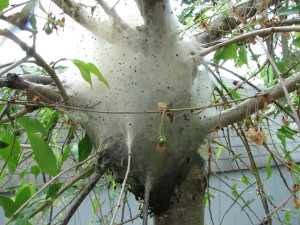Residents Are Seeing More Tent Caterpillars This Season
Several phone calls and e-mails have made their way to Pennsauken Township’s municipal building regarding some new “neighbors” that been introducing themselves over the past few weeks. It seems that residents are seeing more and more fuzzy little tent caterpillars setting up shop in trees across our community. Some e-mails were just simple inquiries; other calls were more… “frantic.” But don’t worry – it’s not an infestation.

If you’ve seen a lot of these around, you’re not alone. It’s not an infestation, but Pennsauken residents are seeing more tent caterpillars than in years past.
The Township has reached out to Camden County’s Division of Environmental Affairs. According to them, the reason you’re seeing so many is that we just had the right conditions for them.
Based on what we’ve read on Wikipedia – and the internet is never wrong – these caterpillars have a “boom or bust” life cycle; you’re either going to see a lot of them, or you won’t see them much at all. Once the caterpillars are fully grown, they look places to spin their cocoons. And in a few weeks, they emerge as moths.
Neither the Township nor the County, or any of other community we’re aware of, have any plans to spray for tent caterpillars. And since most of the trees where these little guys are hanging out are on residential properties, it’s the responsibility of the property owner to remove the caterpillar nests. Also, while the nests are unsightly, tent caterpillars rarely threaten the health of the tree they occupy.
To prevent caterpillars from nesting in your trees, there are products such as “sticky tree bands” that catch them before they can start a nest. And according to another quick internet search, there are several methods remove tent caterpillar nests once they are established, everything from scooping out the caterpillars by hand – a procedure for those without a fear of bugs – to cutting out the section of branches where the nest resides.
So if you happen to see more of our new “locals” than usual, don’t panic. Before you know it, they’ll transform into moths and fly away, leaving your backyard – and your trees – no worse for wear.


